#and this is regional australia
Explore tagged Tumblr posts
Text
oh my god I forgot it was september 11 trimite ajutor
#i keep forgetting i am the most left-wing person here#to be fair i am very left-wing#and this is regional australia
4 notes
·
View notes
Text
" The Gatekeeper Patrolling " //© Jen City
Music: Danger Twins - Thing of Beauty
#Diversion Dam#Ord River#Kimberley Region#Australia#nature#riverscape#pond#wildlife#Crocodile#Alligator#4K#8K#12K#fpv#drone#reels#aesthetics#wanderlust#explore#follow#discover
19K notes
·
View notes
Text
This is also a bit of a culture query, cos these are all in my house so I genuinely cook with these all (except chicken salt, that's been in my cupboard for ages)
But I'm not from the USA and most people here are, so I wonder if that's similar! Maybe your cupboard is identical to mine. Maybe we use the same stuff but call it something else. Maybe USA has a different relationship with pre mix spices and you use none of it. Maybe you've never heard of pre mix spices. I dunno. That's why I'm asking!
I use plain herbs and spices as well. Especially when making a complex meal I'll do it myself. But I use pre mixes other times, so I'm voting. Voting for a pre mix doesn't mean you don't also use paprika! If you genuinely have no pre mixes in the kitchen tho, then hell yeah, tell me!
Also, I know I haven't listed everything in the world. One, that's impossible. Two, this is a bit of a culture thing so I just checked my kitchen and used those. This selection is representative of me only
(you don't have to be from the USA to vote, obvs, we just all know that's how the results will end up. Please tell me about your spice mixes in other countries!!)
Morrison spice blend: Pepper, tumeric, ginger, cardamom, parsley, salt
Chinese five spice: Star anise, cinnamon, clove, fennel, Sichuan pepper
Chicken salt: Salt, chicken stock, garlic, paprika, pepper, onion, celery
Gluhwein gewurz: Orange peel, cinnamon, lemon peel, star anise, hibiscus, clove
Chimichurri: parsley, garlic, oregano, vinegar, chilli, salt, pepper
Za'atar: thyme, cumin, coriander, sesame seeds, sumac, salt, chilli
Garam masala: coriander, cumin, cardamom, cloves, pepper, cinnamon, nutmeg
#food mention#poll#polls#spices#cooking#my gut instinct says I'm going to be told about some seasonal pumpkin spice blend for the next week#but we don't have that here so I'm not preempting and it's not going on the poll#that a regional thing! that's not in Australia! I'm standing my ground#and hey maybe I'll be wrong#if you're interested i use zaatar more than anything else#it's gentle#goes well in breakfast food when I'm cooking lazy
4K notes
·
View notes
Text



small town going nowhere
#mine#australian gothic#regional gothic#australia#small town gothic#rural gothic#victorian gothic#small town aesthetic#small town photography#small town vibes#small town girl#small town#small town life#rural core#rural australia#ruralcore#rural aesthetic#rural landscape#rural photography#rural decay#rural life#rural#urbex#abandoned#country town#photographer#photography#photographers on tumblr
698 notes
·
View notes
Text
Gudda Gumoo Gorge, Blackdown Tableland, Australia: Blackdown Tableland is a national park in the Central Highlands Region, Queensland, Australia. The park is in Central Queensland, 576 km northwest of Brisbane. The Blackdown Tableland is a 900 m sandstone plateau rising abruptly from the plains below. Many creeks on the Tableland have developed gorges and waterfalls along their courses, the most notable of which drains in to the spectacular Rainbow Falls (Gudda Gumoo) over a 40 m drop. Wikipedia
#Gudda Gumoo Gorge#Rainbow Falls#Blackdown Tableland National Park#Central Highlands Region#Queensland#Australia#Oceania#Oceania continent
329 notes
·
View notes
Text

great southern skies | albany | western australia
#scenes from a moving car#photographers on tumblr#western australia#australia#original photographers#landscape#landscape photography#lensblr#photography#nature photography#nature#imiging#female photographers#sunset#sky#purple#orange#silhouette#great southern wa#great southern region#albany#albany wa#cloudcore#clouds
217 notes
·
View notes
Text
Wet Beast Wednesday: box jellyfish
Jellyfish are curious things, but some are curiouser than others. Most jellyfish are members of the class Scyphozoa, which is a very diverse clade with plenty of jellies to choose from. But then there are the Cubozoa, a separate class of jellyfish that have a lot of interesting and unique features, such as being some of the most venomous animals in the world. Try not to get stung.
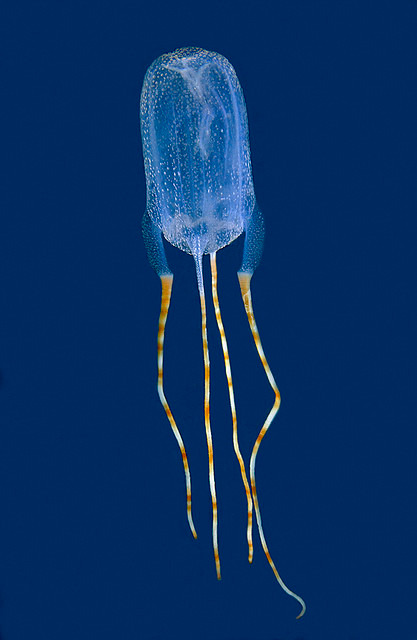
(Image: a box jellyfish. It is a mostly translucent jellyfish with a box-shaped bell. From the corners of the bell hand four tentacles that are a striped white and orange. End ID)
Like the Scyphozoa, the approximately 50 known species of box jellyfish have a body plan consisting of a bell and trailing tentacles. While the Scyphozoa have round bells, box jellyfish have cuboid bells, which give them their name. At each lower corner of the bell is a stalk that leads into one or more tentacles. The interior of the bell is divided into four regions by structures called septa. In each region is a gastric pocket that helps direct food into the central stomach and has structures that help water flow into and out of the animal. Each septa is lined with digestive filaments and two of the jellyfish's eight gonads. In the center of the bell is a flexible, trunk-like appendage called the manubrium which contains the mouth and stomach. When thebox jellyfish eats, it draws prey into the one of the septa where the digestive filaments begin digestion. The manubrium then maneuvers the mouth over to the prey and eats it. Prey is captured with the tentacles, which are lined with stinging cells called cnidocytes which contain structures called nematocysts that inject venom into prey and threats. The tentacles then help move the food into the bell. While Scyphozoa come in a variety of colors, box jellyfish are almost always translucent.
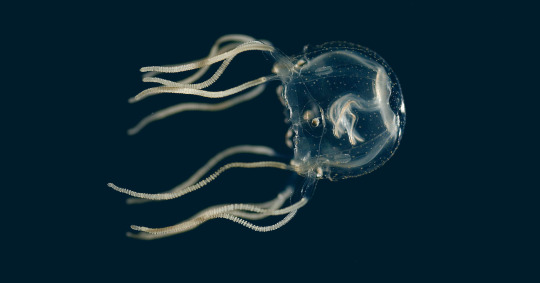
(Image: a box jellyfish, this one having a squatter bell and multiple tentacles at each corner. The manubrium is visible through the bell as a curving, trunk-like structure. End ID)
Box jellyfish have a developed nervous system consisting of two portions: the nerve ring and the rhopalia. The ring nerve stretches around the base of the bell and controls how it moves. The rhopalia is a system of nerves that controls sensory structures. In particular, it controls a sense of gravity and the eyes. While some Scyphozoa have simple light-sensing eyes, the box jellyfish have true eyes with retinas, corneas, and lenses. Like the bell, the rhopalium is divided int four segments. Each segment has two true eyes as well as two simple pit eyes for detecting light levels and two simple slit eyes that likely detect movement. The true eyes can be oriented in different directions and they always appear to keep one pair pointing up. Thanks to their good eyesight and the shape of the bell allowing for rapid bursts of speed, the box jellyfish can actively hunt its prey instead of just drifting and waiting for food to come to them. What's more impressive is their ability to actively navigate their environment and learn to avoid certain threats. It was long thought that animals without brains would not be able to truly learn, but multiple types of cnidarians have shown learning behavior, with the box jellyfish seeming to be the most advanced.
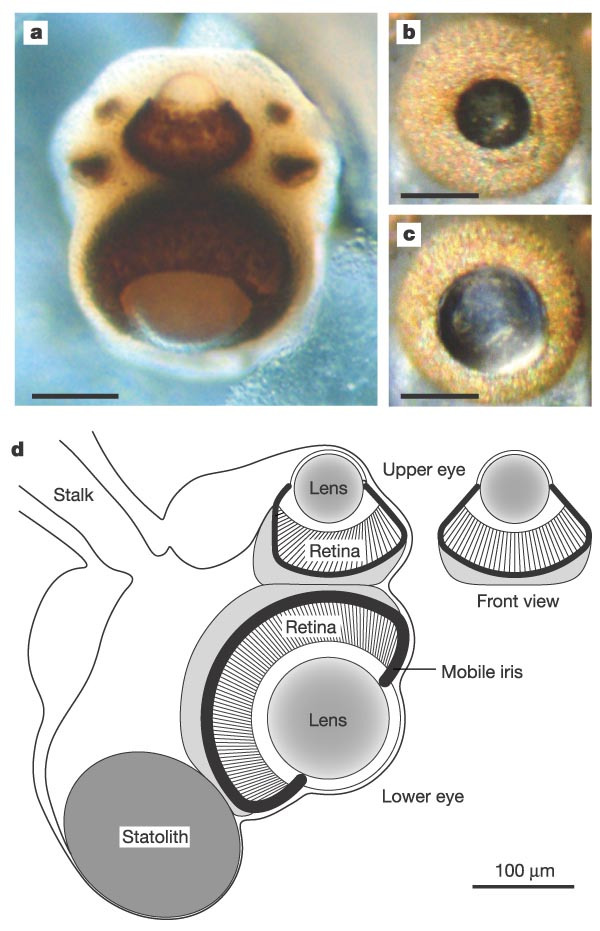
(Image: a scientific diagram showing pictures of a box jellyfish eye and a drawing of its anatomy. End ID. Source)
Box jellyfish reproduce every year and are semelparous, meaning they only mate once before dying. However, there is some inconclusive evidence that the species Chiropsalmus quadrumanus may be able to mate multiple times. Reproduction can be both internal and external depending on species. In external reproduction, the male and female release gametes into the water. In internal reproduction, the pair will maneuver themselves so the openings of their bells face each other and the male will pass a packet of sperm to the female. In these species, the female retains the eggs internally until they hatch. The juveniles hatch as a type of swimming larva called a planua. The planua will eventually settle and become fixed to a hard surface, metamorphosing into a polyp. The polyp is a non-swimming stage found in all members of the clade Medusuzoa, of which the box jellyfish are a member. Polyps will grow for months to years and during this period, they can reproduce asexually by budding off clones of themselves. Eventually, the polyps will metamorphose into the adult medusa stage
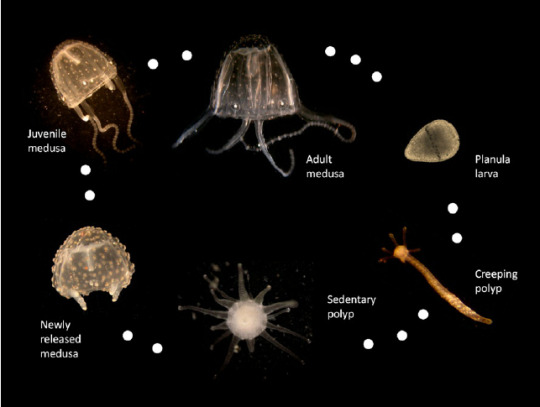
(Image: photos of a box jellyfish at different stages of its life cycle. It starts as a bean-shaped planula, progresses to a worm-like creeping polyp, then to an anemone-like sedentary polyp, then to a newly released medusa, which looks like a tentacle-less box jellyfish. The medusa them matures to a small juvenile and finally a mature adult. end ID)
Box jellyfish are found worldwide in tropical waters, though most known species are from the Indo-Pacific. It is likely that many species ave been overlooked as their transparency and frequently small size makes it easy to miss them. New studies using e-DNA, DNA that is shed and collected through the environment, may help identify nee species and populations. Box jellyfish are known to most people as being some of the most venomous animals in the world, but only a few species are dangerous to humans. The species Chironex fleckeri is the most dangerous to humans. Its venom causes extreme pain and can lead to death within 2-5 minutes if enough venom enters the system. C. fleckeri has caused over 60 recorded deaths in Australia (because where else would it live?) and while there is now an antidote to the venom, getting it to the victim fast enough can be challenging. A singe C. fleckeri is often said to carry enough venom to kill 60 people. Most reported cases of stings have not ended in death as not enough venom was introduced to the system. Also from Australia (of course) are the Irukandji, a group of about 16 similar box jellyfish that can also be lethal, but while C. fleckeri at least has the decency to be big, the Irukandji jellyfish are all tiny. Their venom causes a reaction called Irukandji syndrome that is delayed for up to 2 hours after the sting and can lead to cardiac arrest if not treated. Jellyfish nets are common sights on Australian beaches. They enclose parts of the water with nets that have mesh small enough to keep most jellyfish out. Application of vinegar to the sting is the current recommended treatment and many beaches in Australia are required to stock it, though some research has indicated that vinegar may actually make the sting worse.

(Gif: footage of the rare spotted box jellyfish. It has a large bell with stripes and rings on it and the tentacles are thick and reddish. It is swimming, showing off the movement of the bell in how it propels itself. End ID)
#wet beast wednesday#I wanted to make a fakemon based on these for my australia region#but couldn't think of anything that tentacruel and nihilego haven't covered already#box jellyfish#jellyfish#cubozoa#medusozoa#cnidarian#invertebrates#invertblr#venomous#marine biology#biology#ecology#zoology#animal facts#educational#informative#image described
176 notes
·
View notes
Text

Daily Nagoriyuki 21082024
#daily nagoriyuki#nagoriyuki#guilty gear#To me penguins are inherently cold region animals and then I sometimes remember you can find them also in places like NZ or Australia#I think that’s pretty wild
108 notes
·
View notes
Text
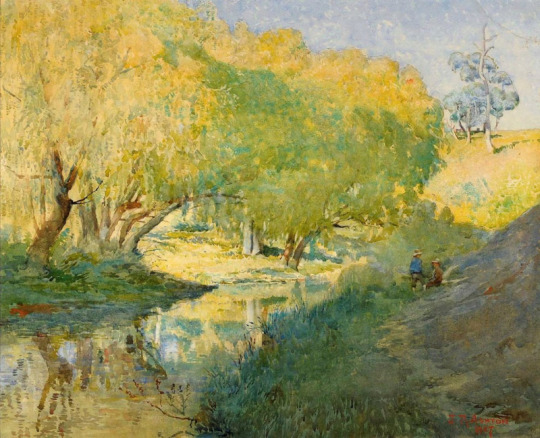
Golden Willows, Julian Ashton, ca. 1907
#art#art history#Julian Ashton#landscape#landscape painting#landscape art#plein air#Impressionism#Impressionist art#Australian Impressionism#Heidelberg School#Australia#Australian art#20th century art#watercolor#New England Regional Museum of Art
116 notes
·
View notes
Text

Dinosaur Trail, Muttaburra, Australia: Muttaburra is an outback town and locality in the Barcaldine Region, Queensland, Australia. Muttaburra was the discovery site of the Muttaburrasaurus, one of Australia's most famous dinosaurs. Wikipedia
82 notes
·
View notes
Text
when i was out driving today, i had stopped to give way for a few cars. now, as a learner that’s pretty obvious that others will jump ahead and take advantage because they’re weird like that, but, you don’t understand.
there was this tired around 40~ ish years old man driving past me with the OG Ash Ketchum hat and the blue vest.
guys.
Ash Ketchum overtook me on the road today.
#silv.ex#I’ve never been so shocked before lol#Ash? In Australia? More likely than you rhubk#Is this a sign that the next region is here? Or one of the future regions /j#Also wow did being off the show aged him heh#Reminds me of that one vid with the voice actors of Ash and Misty driving at a dead end#Anyways stay safe on the roads and all that
14 notes
·
View notes
Text
Ugh I burned the roof of my mouth on my chicken parmigiana last night because I was too excited to wait for it. The hubris of man is staggering.
#I was no longer on a Kart track in regional Australia I was on Suzuka I tell you what#I also have a bruise from the Kart harness and squeezing my chubby body into it#I was so slow and I have a bruise from how I was taking those curbs 😂😂😂#and I’m about to run 14km#help
22 notes
·
View notes
Text

Was bored and made a Exeggutor variant form for if there is ever a Australian based pokemon region.
They accidentally came out more dragon like than tree but that could add to the more mysterious creepiness of these white waking ghosts since their bark is ashy white.
I can see them being slightly feared or in Aboriginal ghost stories yet respected? As they are based off local Gum Tree’s.
#art#pokemon#Oc#Fakemon#Pokemon Variant Form#Exeggutor#Australia form#Austra’s Region?#don’t know what name to use for a Australian region#Grass/Poison
10 notes
·
View notes
Text
Australian Outback Gothic
- You see the same eastern brown snake on the trail, it only hisses you. You hide under the jacaranda tree. The hisses from the trail are still heard. One day the hissing stops, only the long grass remains. The eastern brown snake is gone. You do not go into the long grass.
- No one knew how they landed on the frontier, the men screamed with “rage”. The flame trees blazed across the bush. A black bird cries death.
You gone walkabout through the northern territory. There is a man who says he’s not from around here. He tells you he grew up here. You wonder if he is a dust eater. No one is from the down under anymore.
- You stop a cabbie. “take me to Queensland” you say. He drives you around in circles. You arrive in Queensland. It doesn’t look like Queensland. You left the banana land long ago. The driver fronts up in Queensland. It’s not the same one you know.
- “Have you ever left the down under?” the man asks. “I was born here I never left.” “Have you ever left the down under?” He asks again. He keeps asking. You realise you are not even in the down under.
- One premier falls on her own sword. The lies were revealed. She wasn’t fair dinkum. They replace her with another. There’s plenty of swords to go about.
#australian gothic#australia#regional gothic#rural gothic#gothic#booksarelife#politics#victoria#00’s#locative gothic#straya#regonial gothic
31 notes
·
View notes
Text

#today someone asked me what part of Victoria i lived in and i responded ‘the evil part’ i don’t know why i did that#mine#australian gothic#mornington peninsula#regional gothic#peninsula gothic#australia#small town gothic#rural gothic#victorian gothic#small town#small town aesthetic#small town photography#small town vibes#small town girl#small town life#rural core#rural australia#ruralcore#rural aesthetic#rural landscape#rural photography#rural decay#rural life#rural#religious imagery#religious art#gifset#my gifs#ethel cain
706 notes
·
View notes
Text

Bungle Bungle Range, Australia: The Bungle Bungle Range is a major landform and the main feature of the Purnululu National Park, situated in the Kimberley region of Western Australia. The distinctive beehive-shaped towers are made up of sandstones & conglomerates. These sedimentary formations were deposited into the Red Basin 375 to 350 million years ago, when active faults altered the landscape. The combined effects of wind from the Tanami Desert and rainfall over millions of years shaped the domes. Wikipedia
#Bungle Bungle Range#Purnululu National Park#Kimberley region#Western Australia#australia#oceania continent
145 notes
·
View notes